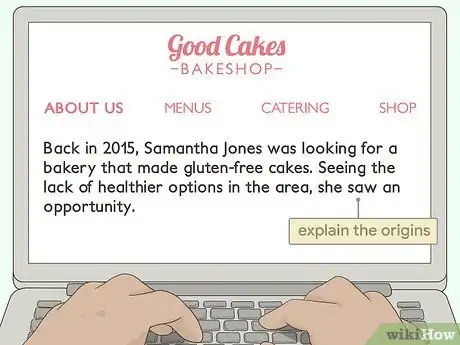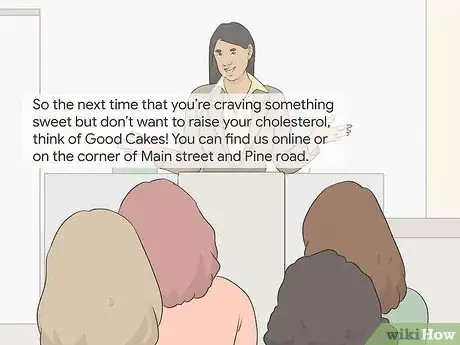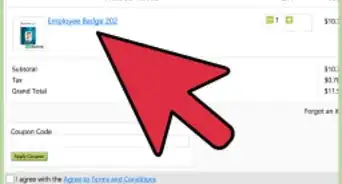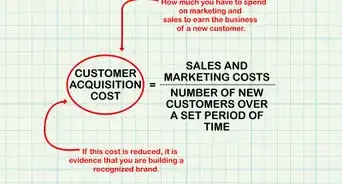This article was co-authored by Madison Boehm and by wikiHow staff writer, Eric McClure. Madison Boehm is a Business Advisor and the Co-Founder of Jaxson Maximus, a men’s salon and custom clothiers based in southern Florida. She specializes in business development, operations, and finance. Additionally, she has experience in the salon, clothing, and retail sectors. Madison holds a BBA in Entrepreneurship and Marketing from The University of Houston.
There are 9 references cited in this article, which can be found at the bottom of the page.
This article has been viewed 288,715 times.
Creating a good first impression is important for any business, especially if it’s a new company that doesn’t have a big reputation yet. There are several ways to introduce your company online, in an introduction letter, marketing materials, and in elevator pitches. Emphasize the problem that your company’s service or product solves, and explain what makes your company unique. Remember, introductions are meant to be short, so don’t overdo it.
Steps
Sending an Introduction Letter or Email
-
1Introduce yourself and the name of your company. To start an introductory letter for your company. Introduce yourself by providing your name. A simple “I am” statement works perfectly well. Include the company that you operate or represent in the next sentence of your introduction. Keep a formal tone throughout the letter to avoid coming off as too familiar or presumptuous.[1]
- For example, the owner of a bakery introducing her business may start, “I am Samantha Jones, and I am the owner and operator of Good Cakes.”
- If you’re sending a physical letter, write it on your company letterhead.
-
2Explain what your company does and what its mission is.[2] After you’ve established who you are and the company that you represent, expand on the company’s goal and purpose. Include information about when you started solving a problem or providing a service. Include 3-4 sentences on the subject of your company and its goals.[3]
- For example, the letter may go on to say, “Good Cakes specializes in gluten-free baked goods, with a specific emphasis on cakes. In 2015, Good Cakes was founded with the goal of providing a healthy alternative to high-fat cakes for the people of Springfield.”
Advertisement -
3Expand on why you’re writing your letter. Next, provide some information on why you’re sending your letter. If you’re making a simple introduction, let your reader know that you’re simply introducing yourself and saying hello. If you’re seeking investors, explain why your company is profitable and worth investing in. If you’re trying to form a partnership, provide an outline of your idea for the partnership. Include 2-4 sentences on your reason for writing your letter.[4]
- If you’re writing to introduce yourself, say, “I am writing to inform you that we have opened a new location on Main street. We’d love to have you stop by some time and check our operation out.”
- If you’re writing a potential investor, say, “We are seeking additional financial support as we expand through the region. Our profits were up 40% last quarter, and the word-of-mouth customer base is loyal.”
- If you’re writing a potential partner, say, “We are seeking a high-quality flour distributor to work with. We believe that you may be a phenomenal partner, and I would love to sit down and find a way to work together.”
- Don’t get too detailed here. This is your first time interacting with the reader and if you go into too much detail, they may be turned off and simply stop reading.
-
4Include next steps and suggest a meeting or conversation. To finish, suggest a formal meeting or casual sit-down to discuss next steps. Giving a concrete way to meet, talk, or sit down and discuss your ideas provides your reader with a clear option to move forward. Close your letter out by providing your reader with your contact information and a note about hoping to speak soon.[5]
- For example, you could say, “If you’d like to sit down and discuss this further, contact my office and let me know what time works best for you. I can be reached at 555-5555. I hope to hear from you soon.”
- Include your title, name, and a formal salutation, like “sincerely.”
- Proofread your introduction before sending it. If you have any typos or errors, your reader may catch them and assume you aren’t worth working with.
Launching on Social Media
-
1Create a business account on Facebook and Twitter. While there are dozens of options when it comes to social media, Twitter and Facebook are undoubtedly the most popular platforms for businesses. They allow you to interact with customers directly without spending any money on marketing materials. Go to each site and sign up for a an account using your business email.[6]
- On Facebook, click the “Create a Page” button in the top right corner from your personal account. Select “Local Business” and sign up to link it with your personal profile. There are no special business accounts on Twitter—they’re the same as regular profiles.
- If your company is trying to develop a youth-oriented brand, sign up for an Instagram account as well.
- Register your company on Yelp and Google to make it easier for people to find your business. These aren’t great social media sites for marketing though, since users can’t “follow” specific businesses and you can’t post anything.
-
2Make your profile appealing with a fun description and photos. In the “Introduction” and “About” sections, give a fun snapshot of your company using friendly and playful language. Upload a profile photo of your logo. On Facebook, upload additional photos of your storefront, employees having fun, and any artful photos of your products or services. Include your location and a link to your company’s website.[7]
- For example, a bakery’s profile description might read, “Springfield’s most delicious bakery! Brownies, strudels, cookies, and muffins! Come get your favorite treat at Good Cakes with half of the calories!”
- If you don’t have a logo, use a photo of one of your products, your storefront, or a smiling employee as your profile photo.
-
3Add people as friends on Facebook and followers on Twitter. To draw attention to your business, start adding and following people. If your service is digital, don’t worry about where the people are located. If you’re a local business with a physical store, try to add people that live in your area on Facebook. The more people that follow you back or add your page, the higher your profile will appear in online searches.[8]
- On Twitter, playfully commenting on the Tweets posted by your competitors is a common way to build your company’s profile.
- This can be a pretty time-consuming process, but waiting for your company to grow on social media on its own is a bad strategy.
-
4Offer discounts or special deals to your followers and fans to attract business. To encourage people to interact with you on social media, offer a discounted price or special deal to new followers. Make your first post an announcement declaring your deal for your fans and friends. This way, people will have an immediate incentive to engage with you online.[9]
- Special deals could include a free tote bag, buy 2 get 1 free, raffles, or a reduced price on a specialized service.
- Include a photo of your product or service alongside your first post. For a bakery, this could be a close-up photo of a delicious, frosted cake.
- An announcement may read, “Come one! Come all! Follow our Twitter or Facebook page and get a free cupcake with any purchase. Come on down to Good Cakes and show us that you’ve followed our account to claim your bonus treat!”
-
5Respond and interact with people commenting on your page. If you treat your Facebook and Twitter profiles as static forums for announcements, people will not be inclined to interact with you. To ensure that people come back to your profile regularly, respond to comments on your page and posts. This will make your business accessible to people online while giving your company a human touch.[10]
- Don’t be uptight. When people post jokes or funny comments, respond with a joke of your own or a simple “That’s hilarious!” This will give your company the image that it’s responsive and operated by real people with a sense of humor.
-
6Update your account regularly to stay engaged. Regularly post announcements, special deals, and photos of your products or services. Posting regularly will ensure that your company shows up in your followers’ timelines and Twitter feeds. This will keep you relevant and ensure that followers and friends engage with your brand.[11]
- Don’t overdo it by posting more than twice a day. If you’re popping up too often on your followers’ feeds and timelines, viewers may grow tired of seeing your posts. Posting once every other day is a good way to be consistent online.
Creating an Engaging Website
-
1Determine the goal of your introductory materials. If you’re creating an “About Us” tab or crafting a homepage for your website, your introduction should provide readers with your company’s background and history. If your introduction is going to be used for marketing materials, brochures, or presentations, you’ll want to emphasize your company’s services and mission. Start by determining who your introduction is actually for to help you figure out what information you want to include.[12]
- For example, a short story about your father inspiring you to start a design firm is totally appropriate for an “About Us” page, since your reader is likely seeking background information. It won’t be the right move in a brochure you’re designing to appeal to clients, though.
-
2Begin by introducing your company’s name and service. To orient your reader and emphasize your company’s services, start by introducing the name. Then, immediately include your business’s service or product so that your reader can immediately identify what your company actually does. If you don’t include the service or product, people will be confused about what your company actually does and may simply stop reading.[13]
- Unless you’re operating a family business or really want to emphasize the personal touch that your company has, avoid using the pronoun “I.” Instead, speak in the third person from the company’s perspective.
- If you’re creating an “About Us” page for a bakery, start with something like, “Good Cakes is a modern bakery that makes delicious cakes, cupcakes, and strudels!”
- If you’re creating marketing materials, you might say, “Good Cakes is a modern bakery specializing in high-end baked goods.”
-
3Explain the origins of your company to provide some context. To give your reader some information about your company’s origins, spend 1-3 sentences explaining how your company started. If the story isn’t particularly interesting, keep it shorter. Include any relevant details about your funding, inspiration, partners, or motivation for starting the business.[14]
- If you’re creating an “About Us” page, you could say, “Back in 2015, Samantha Jones was looking for a bakery that made gluten-free cakes. Seeing the lack of healthier options in the area, she saw an opportunity.”
- If you’re introducing marketing materials, say, “Good Cakes was created in 2015 with the goal of bringing gluten-free cakes to the public.”
-
4Emphasize what makes you unique to stand out. Close your introduction by illustrating what makes your service special. One way to do this is to ask regular clients or customers why they’re attracted to your business. Another way to do this is to focus on your mission statement and emphasize your company’s philosophy towards the niche that it fills. Close your intro with 2-3 sentences about why your business is unique.[15]
- For the bakery business, this might be, “While most bakeries look to cut corners and hook customers by using lower-quality ingredients and too much sugar, Good Cakes believes that cake can be both delicious and healthy.”
-
5Be concise and avoid over-explaining to keep your reader’s attention. Take a look at “About Us” pages for major companies and you’ll notice that they tend to be less than a paragraph. Most readers examine an introduction because it’s short and provides an efficient summary of company’s services and goals. Keep your introduction less than 1 paragraph to avoid presenting too much information.[16]
- You may be able to get away with a longer introduction if your company has a really fascinating story. It better involve some really fascinating details if you’re going over a paragraph though!
-
6Proofread your introduction multiple times to avoid looking unprofessional. Once you’ve constructed a draft of your introduction, proofread it. Read it out loud and look for any mistakes or unclear language. Then, proofread it again. If there is a typo, grammar mistake, or punctuation error, your company could appear sloppy and unprofessional. Fix any errors to avoid coming off as incapable of running a serious company.
Tip: Share your introduction with other employees or business partners to see if they have any productive feedback for you.
Making In-Person Introductions
-
1Shake their hand and introduce your name and position. This may sound obvious, but running up to someone and reciting information is a great way to turn people off to engaging with you. Start by extending your hand and give them a firm handshake and a smile. Tell them your name and your position at the company if it’s a networking setting like a convention or investor’s meeting. If it isn’t, start with some small chat and ask them how they’re doing.[17]
- For the owner of a bakery, this is as simple as saying, “Hello! I’m Samantha Jones, owner and operator of Good Cakes in Springfield.” Creating a personal connection to the other person is always helpful.[18]
Tip: If you aren’t in a business setting, start by asking the other person how they’re doing. Comment on the weather, setting, or ask them an impersonal question to prompt a conversation.
-
2Maintain a pleasant conversation and find openings to talk business. You’re going to come off as pushy and aggressive if you jump right into the business stuff. Chat casually and make positive comments for a few minutes to establish some rapport with the person you’re talking to. When the energy is right, feel free to talk shop and discuss your business. Explain what your business does and discuss your goals for the near future.[19]
- Treat the conversation like a normal chat. If you act like you’re not speaking to a real person, you’ll come off as rigid and distant.
- Mentioning the positive elements of your business is as easy as saying, “Business has been really good over the past year. Our numbers are up and we’re thinking about expanding.”
-
3Ask questions about the other person to develop the conversation. If you spend the entire interaction only talking about yourself, you’re not going to develop a meaningful relationship. Ask probing questions like, “So what business are you in?” and, “I’d love to hear about how you grew your company!”[20]
- Don’t go over the top and ask deeply personal questions or anything relating to finance. Even if you’re talking money, asking questions like, “What is your company worth?” is inappropriate during an introduction.
-
4Shift into your elevator pitch when prompted. An elevator pitch is a 30-second introduction that is designed to entice clients or customers to use your service. When your conversation shifts into what your company can offer, move into your elevator pitch to create a quick snapshot of what your company can do for the person you’re talking to.[21]
Tip: It’s called an elevator pitch because you should theoretically be able to recite it while you’re on an elevator with someone that you’ve just met. It should be short, punchy, and evocative.
-
5Keep your pitch shorter than 30 seconds to stay focused. If you ramble on for too long when talking to potential customers or clients, they may feel overwhelmed or cornered.
-
6Craft the hook for your pitch based on the problem solved by your product or service. To start, take your product or service and ask yourself why someone would need it. Then, think about the frustrations and problems that may occur if the problem remains unsolved. Provide 1-2 sentences about the need for your product.[22]
- For example, an elevator pitch for a bakery that focuses on healthier baked goods might start, “Have you ever had a piece of cake and immediately felt like you did something wrong?” This emphasizes the problem presented by most baked goods (they’re unhealthy for you) by making the problem specific and personal.
- You can add a second sentence to add some detail if you’d like. For the baked goods pitch, this might sound like, “There’s no denying that cake is delicious, but we all know that it’s bad for you.”
-
7Demonstrate how your company solves the problem. After you’ve hooked your listener and demonstrated the problem, explain how your company solves it. This can be an explanation that breaks the solution down into smaller steps, or a simple demonstration of your company’s product or service. Add 2-3 sentences about your company’s solution to the problem.[23]
- For example, you may say, “At Good Cakes, we use a gluten-free flour blend and pure granulated sugar to cut back on the carbs and saturated fat. We use high-end ingredients sourced locally to ensure that each bite is savory and delicious.” This is a good demonstration because it’s clear, but evocative. A few powerful words, like “savory” and “high-end,” help the listener form an emotional connection to your company.
-
8Finish by presenting actionable next steps and contact information. To close your elevator pitch out, explain how the listener can find you and use your service. Finish with 2-3 sentences explaining what the listener should do the next time that they encounter the problem. Include a way to find you so that potential clients and customers know where to go.
- Get a business card so that you can just hand out your contact information in a professional manner.
- For the bakery pitch, it might end with, “So the next time that you’re craving something sweet but don’t want to raise your cholesterol, think of Good Cakes! You can find us online or on the corner of Main street and Pine road.”
-
9Give them your contact information and express interest in meeting again. As your chat comes to a natural close, hand them your business card or phone number. Shake their hand again and thank them for taking the time to talk to you. Say something like “I’d love to get coffee sometime and chat some more” or, “I’d really appreciate the opportunity to sit down and get more in-depth.” Ask them for their business card and conclude the conversation.[24]
Expert Q&A
-
QuestionHow do you introduce a company to an investor?
 Madison BoehmMadison Boehm is a Business Advisor and the Co-Founder of Jaxson Maximus, a men’s salon and custom clothiers based in southern Florida. She specializes in business development, operations, and finance. Additionally, she has experience in the salon, clothing, and retail sectors. Madison holds a BBA in Entrepreneurship and Marketing from The University of Houston.
Madison BoehmMadison Boehm is a Business Advisor and the Co-Founder of Jaxson Maximus, a men’s salon and custom clothiers based in southern Florida. She specializes in business development, operations, and finance. Additionally, she has experience in the salon, clothing, and retail sectors. Madison holds a BBA in Entrepreneurship and Marketing from The University of Houston.
Business Advisor, Jaxson Maximus Focus on making a personal connection with the investor. If you focus solely on pitching the financials or technical details, they might get bored.
Focus on making a personal connection with the investor. If you focus solely on pitching the financials or technical details, they might get bored. -
QuestionHow do you make a good elevator pitch?
 Madison BoehmMadison Boehm is a Business Advisor and the Co-Founder of Jaxson Maximus, a men’s salon and custom clothiers based in southern Florida. She specializes in business development, operations, and finance. Additionally, she has experience in the salon, clothing, and retail sectors. Madison holds a BBA in Entrepreneurship and Marketing from The University of Houston.
Madison BoehmMadison Boehm is a Business Advisor and the Co-Founder of Jaxson Maximus, a men’s salon and custom clothiers based in southern Florida. She specializes in business development, operations, and finance. Additionally, she has experience in the salon, clothing, and retail sectors. Madison holds a BBA in Entrepreneurship and Marketing from The University of Houston.
Business Advisor, Jaxson Maximus Try to be as straightforward as possible. Right off the bat, say something like, "We do X, Y, and Z." This way, it's very clear and defined what your business is all about.
Try to be as straightforward as possible. Right off the bat, say something like, "We do X, Y, and Z." This way, it's very clear and defined what your business is all about.
References
- ↑ https://www.letters.org/introduction-letter/company-introduction-letter.html
- ↑ Madison Boehm. Business Advisor, Jaxson Maximus. Expert Interview. 24 August 2021.
- ↑ https://www.entrepreneur.com/article/252952
- ↑ https://www.entrepreneur.com/article/252952
- ↑ https://www.entrepreneur.com/article/252952
- ↑ https://www.business.qld.gov.au/running-business/marketing-sales/marketing-promotion/online-marketing/social-media
- ↑ https://www.forbes.com/sites/briansutter/2017/07/14/21-ideas-for-social-media-content-for-your-small-business/#13c578ec3011
- ↑ https://www.business.qld.gov.au/running-business/marketing-sales/marketing-promotion/online-marketing/social-media
- ↑ https://www.business.qld.gov.au/running-business/marketing-sales/marketing-promotion/online-marketing/social-media
- ↑ https://www.business.qld.gov.au/running-business/marketing-sales/marketing-promotion/online-marketing/social-media
- ↑ https://www.business.qld.gov.au/running-business/marketing-sales/marketing-promotion/online-marketing/social-media
- ↑ https://www.inc.com/erik-sherman/7-essential-tips-for-a-good-elevator-pitch.html
- ↑ https://www.careeraddict.com/write-company-profile
- ↑ https://www.careeraddict.com/write-company-profile
- ↑ https://www.forbes.com/sites/chicceo/2013/02/05/how-to-create-an-elevator-pitch/#8ca911561eb4
- ↑ https://www.forbes.com/sites/chicceo/2013/02/05/how-to-create-an-elevator-pitch/#8ca911561eb4
- ↑ https://www.businessinsider.com/the-best-way-to-introduce-yourself-2015-10
- ↑ Madison Boehm. Business Advisor, Jaxson Maximus. Expert Interview. 24 August 2021.
- ↑ https://www.businessinsider.com/the-best-way-to-introduce-yourself-2015-10
- ↑ https://www.forbes.com/sites/chicceo/2013/02/05/how-to-create-an-elevator-pitch/#8ca911561eb4
- ↑ https://www.forbes.com/sites/chicceo/2013/02/05/how-to-create-an-elevator-pitch/#8ca911561eb4
- ↑ https://www.forbes.com/sites/chicceo/2013/02/05/how-to-create-an-elevator-pitch/#8ca911561eb4
- ↑ https://www.forbes.com/sites/chicceo/2013/02/05/how-to-create-an-elevator-pitch/#8ca911561eb4
- ↑ https://www.businessinsider.com/the-best-way-to-introduce-yourself-2015-10





















































































